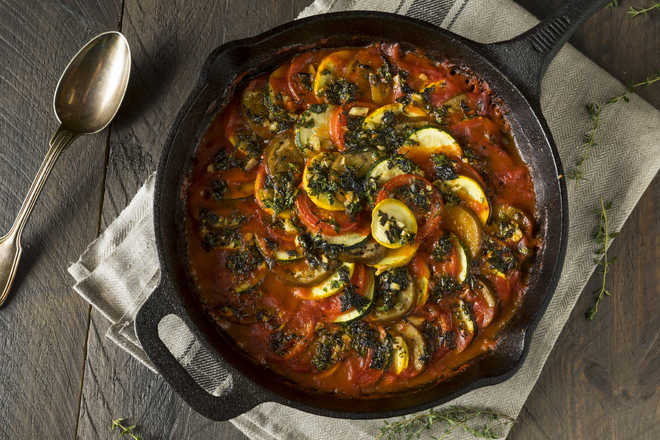Behind world’s oldest proto-curry
Puneetinder Kaur Sidhu
For a very long time after it made its appearance in Europe and America, the glossy purple vegetable variously called baingan, brinjal, eggplant or aubergine was used as a decorative garden plant. That earlier varieties had an over-riding bitter taste and may have had something to do with the vegetable (technically a fruit) thus being rebuffed. It was rendered inedible also on the mistaken belief that it causes a host of maladies, including leprosy and insanity. That the brinjal came from a family closely related to the deadly nightshade (Atropa Belladona), a toxic flowering plant, didn’t quite help its reputation. While tomatoes, potatoes and peppers are an aubergine’s more palatable cousins, ingesting nightshade berries or their juice usually means instant death, and both have been historically employed as a poison. Macbeth, for one, is said to have successfully used it against the Danes trying to invade Scotland. As did, it is said, Locusta, who killed Roman emperor Claudius. Sometime during the Middle Ages, the Italians discovered nightshade’s cosmetic qualities, using a safely watered down juice to dilate pupils to make ladies appear more attractive: belladonna.
But that was then, when the Arabs first carried it back from the Indian sub-continent to Europe and across the Mediterranean Sea to Africa. By the early 20th century, the baingan was well on its way to holding its own in kitchens west of Indian shores. The Lebanese mashed and mixed its unsightly pulp with olive oil and gave the world a delicious dip, baba ganoush. The Greeks turned it into moussaka, a wholesome casserole complete with meat and potatoes. The French lined a dish with neatly sliced eggplant, zucchini, tomatoes, onions, and potatoes, threw in some garlic, baked it, and called it ratatouille. Though the Italians themselves continue to question its antecedents, there isn’t an iota of doubt in our mind where the insanely — pun totally intended — cheesy eggplant parmesan originated. Closer home, to the east, the Chinese douse it in a spicy garlic sauce and slurp it up with noodles. By some accounts, the nutrient-packed eggplant, named so because of a yellowish-white, egg-shaped variety the English-speaking world came in contact with, was first cultivated in southern China, 2,500 years ago.
This theory, though, is in clear danger of being debunked since 2010. That year archeologists Aruna Kashyap and Steve Weber, of the Washington State University in Vancouver conducted an innovative and ground-breaking analysis of starch molecules. These were scraped off surfaces found at the Harappan digs in Farmana, Haryana, and the molecular thumbprints of fruits and vegetables identified. If you’re wondering where this is leading, my answer to you is this: to the inside of a 4,000-year-old handi. To a 4,000-year-old potshard, actually, with traces of baingan, haldi and adrak; leftovers, as it turned out, from the world’s oldest known curry! This discovery led to a whole new respect for the generally ignored — often derided — baingan. It even led to fellow food writer Soity Banerjee recreating the dish just as she imagined the ‘lady from Farmana’ would have made it all those millennia ago. She used her vast culinary knowledge to throw in a few extra ingredients known to be available back then. Raw mango, cumin seeds, sesame oil, sugarcane juice, sweet basil leaves and salt. Stab the internet for her recipe should you also crave a sweet and sour taste of the Indus Valley Civilisation.









